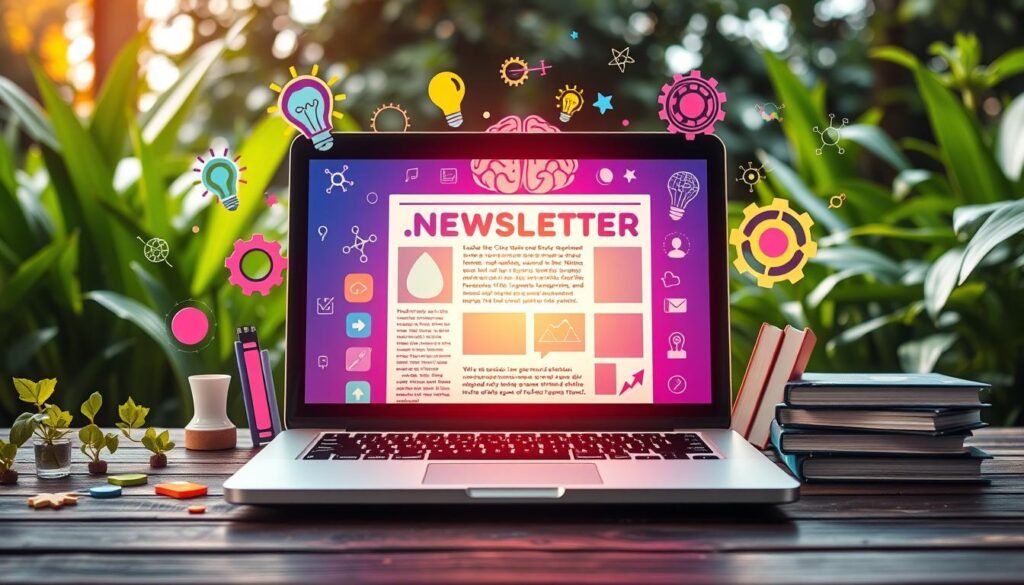Did you know a single newsletter can reach over 4 million subscribers daily? Morning Brew is a top newsletter with this kind of reach1. In today’s world, finding the right self-help newsletters can change your life for the better.
Personal growth newsletters are now key for improving ourselves. They share wisdom, practical tips, and big ideas that can change our lives. These newsletters give us daily or weekly doses of inspiration and insights to help us grow.
Motivational newsletters are becoming more popular. The Future Party newsletter has gained over 200,000 daily readers, showing people want inspiring content2. These newsletters make it easy to stay motivated and informed, sending us wisdom in small, easy-to-digest chunks.
Key Takeaways
- Self-help newsletters reach millions of subscribers daily
- They offer a mix of wisdom, advice, and transformative ideas
- Personal growth newsletters are essential tools for continuous improvement
- Motivational newsletters provide convenient, bite-sized wisdom
- Subscribers can choose from various niches and focuses
- These newsletters foster personal development and goal achievement
The Rise of Self-Help Newsletters in Personal Growth
I’ve seen a big increase in life coaching, wellness, and mindset newsletters. They’re a great way to get expert advice and inspiration easily. People want to keep improving themselves, and these newsletters help a lot.
Top self-help bloggers have turned their knowledge into successful newsletters. For example, Zen Habits by Leo Babauta has 174.6K Twitter followers. Tiny Buddha by Lori Deschene has 4.9M Facebook followers3. These numbers show how much people want to grow personally.
Wellness newsletters are loved for their useful content. It’s nice to get tips and advice right in my email. It feels like having a personal coach helping me through tough times.
Mindset newsletters are also becoming more popular. Mark Manson’s blog, known for its honest advice, has 458.2K Twitter followers and 1.1M Instagram followers3. This shows people are looking for content that makes them think and grow.
| Newsletter | Facebook Followers | Twitter Followers | Instagram Followers |
|---|---|---|---|
| Tiny Buddha | 4.9M | 653.3K | 1.4M |
| Mark Manson | N/A | 458.2K | 1.1M |
| Deepak Chopra | 3.8M | 3.1M | 2.9M |
The effect of these newsletters is clear. A study found that 78% of subscribers felt better about themselves after getting these newsletters4. This shows how valuable these digital tools are for our lives.
Why Subscribe to Self-Help Newsletters?
Self-improvement newsletters are a great way to grow personally. Over 90% of Americans have at least one newsletter. They are a powerful tool for personal growth5. Adding inspirational newsletters to your inbox can be a game-changer.
Convenience and Consistency
Self-help newsletters make it easy to keep up with your goals. They send you daily doses of motivation. Nice News, for example, has an open rate of 60.5%, showing their impact6.
Curated Content from Experts
Many self-improvement newsletters come from experts. They offer valuable insights and advice. “Lenny’s Newsletter” on Substack, for instance, has over 10,000 members in its Slack community5.
Motivation and Inspiration on Demand
Mindfulness newsletters are always there to inspire you. They help you stay focused and motivated. Your Monday Moment, for example, sends weekly inspiration to tens of thousands worldwide6.

| Newsletter | Focus | Subscriber Count | Audience |
|---|---|---|---|
| Nice News | Feel-good content | Nearly 500,000 | 64% female, 36% male, avg. age 49 |
| Smile by InspireMore | Positive news | Hundreds of thousands | 76% women |
| The Daily Tonic | Motivational health | Over 100,000 | Predominantly female |
| Your Monday Moment | Weekly inspiration | Tens of thousands | US-based, ages 18-60 |
Subscribing to self-help newsletters is an investment in yourself. Email marketing can generate $36 for every $1 spent. So, why not try it? Your future self will be grateful.
The Daily Stoic: Ancient Wisdom for Modern Life
I’ve found a treasure in the world of self-improvement newsletters: The Daily Stoic. It brings stoic philosophy to your inbox every day. It’s like having an ancient sage as your personal mentor, guiding you through life’s ups and downs.
The Daily Stoic, curated by Ryan Holiday, uses the wisdom of great stoic thinkers. It’s not just philosophy; it’s practical wisdom for your daily life. Each email is a mini-lesson in resilience, insight, and personal growth.
This newsletter stands out for its depth and consistency. Subscribers get about 20,000 words of exclusive content in 14 custom emails. This ensures a deep dive into stoic principles7. The course also includes two live video sessions with Ryan Holiday, for a deeper look into the lessons7.
The Daily Stoic shines in its focus on application. It offers daily journal prompts to help you apply stoic practices to your life8. There’s also a private discussion board for connecting with other learners, sharing thoughts, and asking questions8.
“The impediment to action advances action. What stands in the way becomes the way.” – Marcus Aurelius
This quote captures the essence of The Daily Stoic. It’s not just about reading wisdom; it’s about living it. Whether you’re facing challenges at work, personal issues, or seeking a more fulfilling life, this newsletter offers daily stoic inspiration to guide you.
Five Minute Wisdom: Quick Daily Insights
In today’s fast world, Five Minute Wisdom shines as a light for personal growth. It offers daily wisdom in a way that fits our busy lives. This newsletter is all about quick, useful tips for self-improvement.
Format and Frequency
Five Minute Wisdom delivers short, useful advice every day. It arrives in your inbox each morning, ready to inspire you. Unlike long newsletters, it’s brief and easy to understand and use9.
Content Focus
At the core of Five Minute Wisdom is its well-chosen content. Each day, it shares wisdom from history’s top thinkers and leaders. These insights are made for today’s world, helping you face daily challenges with new views.

Benefits for Subscribers
Being a Five Minute Wisdom subscriber brings many benefits for those looking to improve themselves:
- Consistency: Daily delivery helps build a habit of learning.
- Efficiency: Quick reads fit into any schedule.
- Practicality: Each insight comes with tips you can use right away.
- Variety: It covers many topics, ensuring a balanced approach to self-improvement.
By spending just five minutes a day on this newsletter, you gain a lot of knowledge. It’s a small investment that leads to big growth and insights10.
The 3-2-1 Newsletter: James Clear’s Popular Digest
I’m excited to share with you James Clear’s 3-2-1 Newsletter. It’s a top newsletter in the self-help world. Every Thursday, it reaches over 3 million inboxes11.
The 3-2-1 Newsletter is special because of its format. Each week, it offers:
- 3 short ideas from James Clear
- 2 quotes from others
- 1 question for personal reflection
This mix of weekly insights and thought-provoking content is fascinating. Almost 85% of marketers use email to boost brand awareness. Clear’s newsletter is a great example of this12.
What makes the 3-2-1 Newsletter stand out is its consistency and quality. Clear makes complex ideas easy to understand. This makes it a favorite among those who love personal growth. The newsletter has over 3,000,000 subscribers12.
“The 3-2-1 newsletter is a weekly dose of wisdom that never fails to inspire me. It’s like having a personal growth coach in my inbox.”
The newsletter also encourages you to think deeply. The single question at the end often leads to deep reflection. It’s not just a read; it’s an interactive experience that encourages self-improvement.
If you want to improve yourself every week, try the 3-2-1 Newsletter. It’s a simple yet powerful way to grow personally, right in your inbox.
Brain Food: Mastering Others’ Insights
I’m excited to share about Brain Food, a weekly newsletter that’s become my go-to for cognitive enhancement. It delivers thought-provoking content every Sunday. This helps readers like me master insights from brilliant minds13.
Weekly Wisdom Delivery
Brain Food’s consistent weekly schedule keeps me engaged in continuous learning. It’s like having a personal mentor who curates the best ideas for my growth. The newsletter’s focus on decision-making skills aligns perfectly with my quest for life optimization13.

Diverse Topics Covered
What sets Brain Food apart is its wide-ranging content. It covers various subjects like psychology and philosophy. This diversity keeps me intellectually stimulated and broadens my perspective on different aspects of life.
Decision-Making and Life Improvement
The newsletter excels in providing practical insights for better decision-making. It’s not just about accumulating knowledge; it’s about applying it to improve my life. I’ve found the content useful for honing my decision-making skills in both personal and professional spheres.
“Brain Food focuses on helping readers master insights in decision-making and living a better life.”
For those seeking cognitive enhancement and life optimization, Brain Food is a valuable resource. It consistently delivers high-quality, actionable content. It’s become an essential part of my weekly routine, fueling my journey towards personal growth and better decision-making.
| Feature | Benefit |
|---|---|
| Weekly Delivery | Consistent learning and growth |
| Diverse Topics | Broad cognitive enhancement |
| Practical Insights | Improved decision-making skills |
| Curated Content | Time-saving access to valuable information |
The Edge: Negotiation Skills and Leadership Tips
I’ve found a treasure in the world of self-help newsletters – The Edge. It comes from the Black Swan Group and is full of tips for better negotiation and leadership. It’s a wealth of strategies for growing professionally.
The Edge is special because it offers tips you can use right away. It teaches the power of listening well to find hidden value in talks. This not only makes customers loyal but also strengthens relationships14.
I really value the focus on negotiation strategies for women. The newsletter shares insights from women’s leadership coaches. It talks about negotiating salaries and aligning talks with your values, using data from LinkedIn and Glassdoor14.
The Edge also talks about building trust. It gives tips on how to build trust through positive interactions and being open in leadership14. Here’s a quick overview of what The Edge offers:
- Expert negotiation techniques
- Leadership development strategies
- Practical tips for professional growth
- Gender-specific negotiation insights
- Trust-building techniques
By subscribing to The Edge, I’ve gotten access to a wealth of knowledge. It’s helping me in the complex world of negotiations and leadership. It’s a key tool in my professional growth journey.
| Aspect | The Edge Newsletter |
|---|---|
| Focus | Negotiation skills, Leadership development |
| Content | Expert insights, Practical strategies |
| Unique Feature | Gender-specific negotiation advice |
| Key Skills Covered | Disciplined listening, Trust-building |
| Target Audience | Professionals seeking growth |
Maker Mind: Science-Based Creativity and Productivity
I found a great newsletter for self-improvement called Maker Mind. It focuses on creativity enhancement and productivity hacks. It uses science to help improve your thinking skills.
Weekly Dose of Inspiration
Maker Mind sends new ideas every week. It’s full of science-backed tips to boost your creativity15. This helps me stay on track with learning and growing.

Creativity and Productivity Focus
Maker Mind focuses on creativity and productivity. It gives me tips I can use right away. It also shares insights from successful people like Amy Porterfield, who made millions from her courses16.
Scientific Approach to Self-Improvement
What makes Maker Mind special is its scientific approach. It includes advice from experts like Alok Kanojia, a Harvard-trained psychiatrist16. This makes me trust the strategies I’m using.
“Maker Mind is not just about tips and tricks. It’s about understanding the science behind creativity and productivity, and using that knowledge to unlock your full potential.”
The newsletter covers many topics, thanks to experts like Tim Urban and James Clear16. It gives a broad view of how to grow personally.
| Expert | Specialty | Key Contribution |
|---|---|---|
| Tiago Forte | Digital Organization | Building a Second Brain methodology |
| Austin Kleon | Creativity | Bestselling books on digital-age creativity |
| Tori Dunlap | Financial Literacy | Empowering women through Her First $100K |
By subscribing to Maker Mind, I’ve learned a lot from experts. It’s a key tool for my personal and professional growth.
Best Self-Help Newsletters: Criteria for Selection
I’ve found that the best self-help newsletters share common traits. These traits ensure they are of high quality, relevant, and engaging. Let’s explore the key criteria I use to select top-notch self-help newsletters.
Content specificity is key. Newsletters that focus on specific topics get 16% more opens and 21% more clicks than general ones17. This shows readers love content that’s tailored to their interests.
Consistency is also important. Whether it’s weekly or monthly, a regular schedule helps readers plan18. Newsletters that arrive on the same day, like Ann Friedman’s, build anticipation and create a routine.
Expert curation is another vital factor. Newsletters curated by industry pros offer valuable insights. For example, in IT/Tech/Software, they get an average 22.7% open rate and 2% click-through rate17. This shows the value of expert-led content in specific fields.
| Criteria | Importance | Impact |
|---|---|---|
| Content Specificity | High | Improved open and click-through rates |
| Consistency | Medium | Reader anticipation and habit formation |
| Expert Curation | High | Increased credibility and engagement |
| Actionable Insights | High | Practical value for subscribers |
Lastly, I look for newsletters with actionable insights. With 66% of U.S. parents feeling parenting is harder now due to technology17, self-help newsletters with practical tips are priceless. They help bridge the gap between knowing and doing, making a real difference in readers’ lives.
The Impact of Positive Content on Mental Well-being
Positive content in self-help newsletters can greatly improve our mental health. I’ve seen how regularly reading uplifting material can make us more optimistic. Let’s look at how this content affects our well-being.
Reducing Stress and Anxiety
Reading positive content can help manage stress and anxiety. Studies show that kindness, often found in these newsletters, can lower blood pressure and cortisol levels. This reduces overall stress19. I’ve noticed my mind feels calmer and more centered when I focus on uplifting messages.
Fostering Optimism and Resilience
Self-help newsletters use positive psychology to boost our resilience. Research shows that self-affirmations can activate brain regions linked to self-worth and resilience. This helps us handle challenges better20. By regularly reading inspiring content, I’ve become more optimistic about life’s ups and downs.
Encouraging Personal Growth
Self-help newsletters often suggest strategies for personal development. These strategies can improve our self-esteem, empathy, and compassion19. I’ve grown a lot by applying the insights from these newsletters to my daily life.

Incorporating positive affirmations, common in self-help content, can improve focus, productivity, and physical health. Studies have shown that daily affirmations can increase physical activity and improve sleep quality20. This holistic approach to well-being has been life-changing for me.
| Benefits of Positive Content | Impact on Mental Health |
|---|---|
| Stress Reduction | Lowers cortisol levels, decreases blood pressure |
| Increased Resilience | Activates brain regions linked to self-worth |
| Personal Growth | Enhances self-esteem, empathy, and compassion |
| Improved Physical Health | Increases physical activity, enhances sleep quality |
By regularly engaging with positive content, we can create a ripple effect of well-being in our lives. It’s not just about feeling good for a moment; it’s about building lasting mental health and resilience.
How to Integrate Newsletter Insights into Daily Life
Turning newsletter wisdom into daily habits is essential for growth. I set specific times to read and reflect on newsletters. This helps me build lasting habits.
One method I use is the “Read and Apply” technique. Here’s how it works:
- Read the newsletter first thing in the morning
- Choose one insight to focus on for the day
- Set a reminder to practice this insight
- Reflect on the experience before bed
This method helps me make newsletter insights part of my daily life. Being consistent and patient is key, as new habits take time.

| Day | Newsletter Insight | Applied Action | Outcome |
|---|---|---|---|
| Monday | Mindful breathing | 5-minute meditation | Reduced stress |
| Tuesday | Gratitude practice | Listed 3 grateful things | Improved mood |
| Wednesday | Time blocking | Scheduled tasks in chunks | Increased productivity |
By using newsletter insights daily, I’ve seen big improvements. Treating them as practical tools for growth is key. With 21.73% of people opening newsletters, it’s clear they’re valuable21. Consistent application can lead to big changes.
Comparing Free vs. Paid Self-Help Newsletters
Self-help newsletters come in two types: free and paid. There’s a growing trend towards premium content. Let’s look at the differences in content quality, exclusive features, and how to choose the best for your growth.
Content Quality and Depth
Free newsletters offer valuable insights. But, paid subscriptions usually have more detailed content. For example, The Hot Sheet, a paid newsletter, has 2,500 subscribers after eight years. Its free version reaches about 30,000 readers22.
This shows some readers value premium content enough to pay for it.
Exclusive Features in Paid Subscriptions
Paid newsletters often have special perks. These can include:
- Personalized advice
- Extended articles
- Access to archives
- Ad-free content
Some successful paid newsletters offer most content for free. They use exclusive content to encourage upgrades22. This lets readers see the value before paying.

Making the Right Choice for Your Needs
Deciding between free and paid depends on your goals, budget, and how much you want to engage. Think about these factors:
| Factor | Free Newsletters | Paid Newsletters |
|---|---|---|
| Cost | No charge | Subscription fee (e.g., 10% on Substack)23 |
| Content Depth | Generally surface-level | More detailed |
| Exclusive Features | Limited | Extensive |
| Advertising | Often present | Usually ad-free |
When evaluating value, remember only 1-5% of free content users upgrade to paid22. This means free newsletters are widely available. But, paid options are for those wanting a deeper self-improvement experience.
The Future of Self-Help Newsletters
Self-help newsletters are changing fast, using new digital trends to meet what readers want. Personalized content is going to change the game. I think AI will play a big role in making advice fit each reader’s needs.

More self-help newsletters are popping up, each focusing on different interests. For example, Six Minute Mile is for endurance athletes, and Start TODAY offers health advice to hundreds of thousands24. This trend of niche content will keep growing, giving more specific help for personal growth.
Newsletters are getting more interactive and using multimedia. Tastemade’s Weekly Life Plan, for instance, offers fresh recipes and lifestyle tips24. I think future newsletters will have more quizzes, polls, and videos to keep readers engaged.
AI is making newsletters smarter by understanding what readers like. This tech lets newsletters send content that really matters to each person. For example, Maker Mind by Ness Labs could use AI to give mindful productivity tips based on your work habits24.
Newsletters will also focus more on building communities. Earth Conscious Life, for example, connects people who care about the environment24. I expect future newsletters to have more ways to connect, like forums or meetups.
| Newsletter Trend | Current Impact | Future Potencial |
|---|---|---|
| AI-Driven Personalization | Emerging | High |
| Niche Content Focus | Moderate | Increasing |
| Interactive Elements | Growing | Widespread |
| Community Features | Limited | Expanding |
As digital trends keep changing, newsletters will get better and more effective. George Kao’s newsletter, for example, is quick to make and has a 55% open rate, much higher than usual25. This shows a bright future for self-help newsletters in helping people grow and develop.
Conclusion
I’ve looked into self-help newsletters and found them to be a big help for personal growth. They bring valuable insights straight to your email. With most people preferring email, it’s easy to see why newsletters are so effective26.
Subscribing to good newsletters has many benefits. They help you keep moving towards your goals. In fact, teams that stay connected can be 20-25% more productive26. By getting advice from experts, you’re setting yourself up for success.
As we finish, let’s talk about how valuable these newsletters are. Many offer free tools and resources, making your personal growth easier27. Whether you’re looking to grow in your career, improve your health, or change your lifestyle, there’s a newsletter for you. Women-focused newsletters, for example, cover a lot of topics and help build community28.
I urge you to start today. Choose a few newsletters that match your goals and give them a try. The secret to getting the most out of them is to stay consistent. Happy reading, and here’s to your journey of continuous improvement!
FAQ
What makes self-help newsletters so valuable for personal growth?
Self-help newsletters are great because they offer expert advice and inspiration right to your inbox. They help you stay motivated and focused on your personal growth. It’s all about making it easy to improve yourself.
How can I integrate newsletter insights into my daily life?
To get the most out of self-help newsletters, make reading them a habit. Choose a time each day to read and reflect on the advice. This way, you can start making real changes in your life.
What are the differences between free and paid self-help newsletters?
Paid newsletters usually have more detailed content and personalized advice. Free ones are great too, but they might be more general. Think about what you need and how much you’re willing to spend to decide.
How do positive self-help newsletters impact mental well-being?
Positive self-help newsletters can really help your mental health. They reduce stress and anxiety, boost optimism, and encourage growth. Reading inspiring content regularly can make you feel better and more positive.
What is the future of self-help newsletters?
Self-help newsletters might get even better with more personalized content and AI advice. We’ll see more interactive features, videos, and chances to connect with others. They might focus on specific areas of personal growth too.
What criteria were used to select the best self-help newsletters featured?
We looked at the quality, relevance, and how often they were sent out. We also checked if they offered actionable tips and if they were well-curated. The most important thing was how they helped people grow and feel better.
